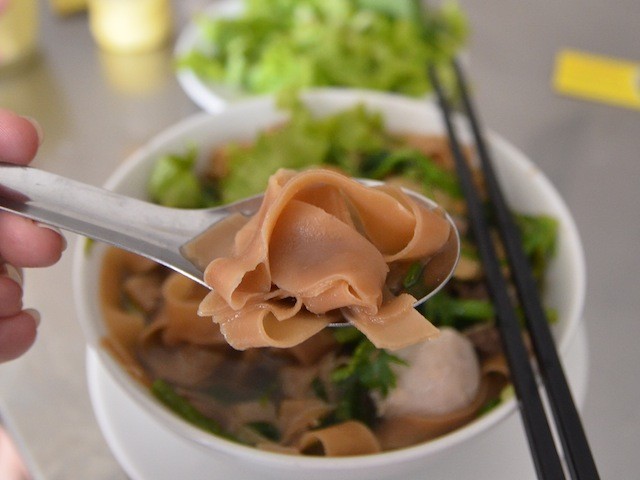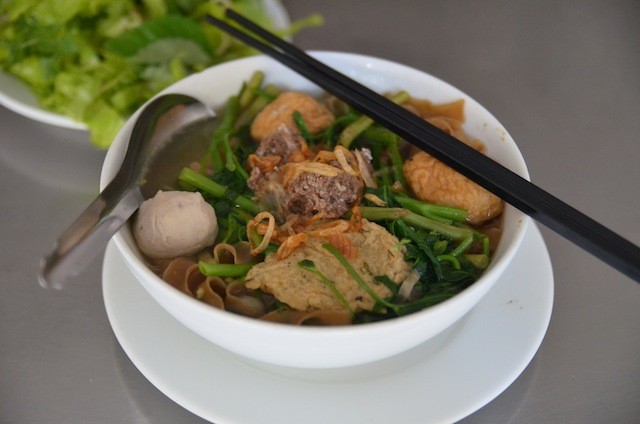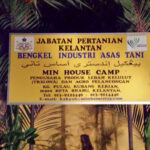Banh Da Cua, a distinctive crab noodle soup originating from Hai Phong, is a must-try for any food enthusiast visiting Vietnam. SIXT.VN is here to guide you to the most authentic and delicious Banh Da Cua experiences in Hai Phong and beyond. Let’s explore the best spots and delve into what makes this dish so special, ensuring your culinary journey is unforgettable. According to research from the Vietnam National Administration of Tourism, in 2023, culinary tourism significantly enhances tourist satisfaction and provides a deeper cultural understanding of Vietnam.
1. What is Banh Da Cua and Why Is It Special?
Banh Da Cua is a Vietnamese crab noodle soup that stands out due to its unique ingredients and preparation method. The dish features “banh da,” a type of flat, reddish-brown rice noodle made from the same dough used for rice crackers, giving it a chewier texture and roasted rice flavor. The broth is rich and flavorful, made from fresh crab, tomatoes, and various spices. It’s typically garnished with fried onions, green onions, and sometimes betel leaf-wrapped beef (bo la lot). This noodle soup is more than just a meal; it’s a culinary experience that encapsulates the essence of Hai Phong’s gastronomic heritage.
1.1. The Origins of Banh Da Cua
Banh Da Cua hails from Hai Phong, a bustling port city in northern Vietnam known for its vibrant culinary scene. The dish has deep roots in the local culture, reflecting the region’s abundant seafood and agricultural resources. According to culinary historians, Banh Da Cua emerged as a creative way to utilize locally sourced ingredients, combining the sweetness of crab with the earthiness of rice noodles and the freshness of local herbs.
1.2. Key Ingredients That Make Banh Da Cua Unique
The distinctiveness of Banh Da Cua lies in its ingredients:
- Banh Da Noodles: These flat, reddish-brown noodles are made from rice flour and have a chewy texture and slightly roasted flavor.
- Crab Broth: The rich and flavorful broth is made from fresh crab, tomatoes, and a blend of spices.
- Crab Meat and Cakes: Fresh crab meat and crab cakes add a delightful seafood flavor.
- Accompanying Greens: Typically served with morning glory, perilla leaves, and shredded lettuce.
- Optional Additions: Some variations include pork balls or “bo la lot” (beef wrapped in betel leaves).
1.3. Nutritional Benefits
Banh Da Cua is not only delicious but also nutritious. It provides a good source of protein from the crab and pork, carbohydrates from the rice noodles, and vitamins and minerals from the vegetables.
- Protein: Essential for muscle repair and overall body function.
- Carbohydrates: Provide energy for daily activities.
- Vitamins and Minerals: Support various bodily functions and boost the immune system.
- Fiber: Aids digestion and promotes gut health.
2. Where Can You Find The Best Banh Da Cua in Hai Phong?
Finding the best Banh Da Cua in Hai Phong involves exploring both well-known establishments and hidden local gems. Here are some highly recommended places:
2.1. Top-Rated Banh Da Cua Restaurants in Hai Phong
- Banh Da Cua Ba Cu: This is one of the most famous Banh Da Cua spots in Hai Phong, known for its authentic flavors and high-quality ingredients.
- Quan Dung: Another popular restaurant that consistently receives rave reviews for its delicious and flavorful Banh Da Cua.
- Banh Da Cua 186 Van Cao: Highly recommended by locals for its rich broth and generous portions.
2.2. Hidden Local Gems
- Street Vendors: Exploring street vendors in Hai Phong can lead to discovering some of the most authentic and flavorful Banh Da Cua experiences.
- Local Markets: Visiting local markets often reveals small, family-run stalls that have been serving Banh Da Cua for generations.
2.3. A Detailed Comparison Table of Popular Spots
| Restaurant | Address | Price Range (VND) | Customer Ratings | Key Features |
|---|---|---|---|---|
| Banh Da Cua Ba Cu | Multiple locations | 30,000 – 50,000 | 4.5/5 | Authentic flavor, fresh ingredients |
| Quan Dung | [Specific address needed] | 25,000 – 45,000 | 4.3/5 | Rich broth, generous portions |
| Banh Da Cua 186 Van Cao | 186 Van Cao Street | 35,000 – 55,000 | 4.6/5 | Highly recommended by locals, flavorful and satisfying |
| Street Vendors | Various locations in Hai Phong | 20,000 – 40,000 | Varies | Authentic, budget-friendly |
| Local Markets | Hai Phong Markets | 20,000 – 40,000 | Varies | Traditional recipes, family-run stalls, unique local experience |
2.4. How to Identify Authentic Banh Da Cua
To ensure you’re getting an authentic Banh Da Cua experience, look for these indicators:
- Fresh Ingredients: The crab should be fresh, and the noodles should have a distinct reddish-brown color.
- Flavorful Broth: The broth should be rich and aromatic, with a balanced blend of sweet, savory, and slightly tangy flavors.
- Local Crowd: A restaurant or stall frequented by locals is often a good sign of authenticity.
 Banh Da Cua Hai Phong
Banh Da Cua Hai Phong
3. What to Expect When Eating Banh Da Cua
Eating Banh Da Cua is a sensory experience that involves understanding the local dining customs and knowing how to enhance the flavors of the dish.
3.1. Understanding the Local Dining Customs
In Vietnam, it’s common to eat Banh Da Cua at small, family-run establishments or street-side vendors. The atmosphere is usually casual and bustling.
- Seating: Often, you’ll find yourself sitting on small plastic stools at low tables.
- Condiments: Expect a variety of condiments on the table, such as chili sauce, lime wedges, and fish sauce.
- Sharing: It’s acceptable to share dishes, especially when dining with a group.
3.2. How to Enhance the Flavors of Banh Da Cua
- Add Lime: Squeeze a wedge of lime into the soup for a burst of acidity that complements the richness of the broth.
- Chili Sauce: Add a small amount of chili sauce for a spicy kick.
- Fresh Herbs: Mix in the provided fresh herbs, such as perilla leaves and morning glory, to add freshness and aroma.
3.3. Potential Challenges and How to Overcome Them
- Language Barrier: Learning a few basic Vietnamese phrases can be helpful. Alternatively, use translation apps or ask for assistance from locals.
- Finding Authentic Spots: Use online reviews and recommendations from locals to find the best spots.
4. Exploring Hai Phong: More Than Just Banh Da Cua
Hai Phong is a city with much to offer beyond its famous crab noodle soup. Make the most of your visit by exploring some of its other attractions.
4.1. Must-Visit Attractions in Hai Phong
- Do Son Beach: A popular beach resort known for its scenic beauty and recreational activities.
- Cat Ba Island: The largest island in Ha Long Bay, offering stunning landscapes, beaches, and opportunities for hiking and kayaking.
- Du Hang Pagoda: A historic pagoda with beautiful architecture and serene surroundings.
- Hai Phong Museum: A museum showcasing the history and culture of Hai Phong.
4.2. Other Local Delicacies to Try
- Nem Cua Be: Crab spring rolls, a delicious and crispy appetizer.
- Oc: Various types of snails cooked in different sauces, a popular street food.
- Banh Mi Que: A small, crispy baguette filled with pate and pork floss.
4.3. Planning Your Trip: Accommodation and Transportation
- Accommodation: Hai Phong offers a range of accommodation options, from budget-friendly guesthouses to luxury hotels. SIXT.VN can assist with finding the perfect accommodation to suit your needs and budget.
- Transportation: Getting around Hai Phong is easy with taxis, motorbikes, and buses. Consider using SIXT.VN’s transportation services for convenient and reliable airport transfers and city tours.
 Woman enjoying Banh Da Cua
Woman enjoying Banh Da Cua
5. How SIXT.VN Can Enhance Your Culinary Journey in Hai Phong
SIXT.VN offers a range of services to make your culinary journey in Hai Phong seamless and enjoyable.
5.1. Tailored Travel Itineraries Focused on Food
SIXT.VN can create personalized travel itineraries that prioritize your culinary interests, ensuring you experience the best of Hai Phong’s food scene.
- Customized Food Tours: We can arrange guided food tours that take you to the best Banh Da Cua spots and other local eateries.
- Cooking Classes: Learn to make Banh Da Cua yourself with our cooking class packages.
5.2. Convenient Transportation Options
- Airport Transfers: Start your trip stress-free with our reliable airport transfer services.
- Private Car Services: Explore Hai Phong at your own pace with our private car services.
5.3. Accommodation Booking Services
- Wide Range of Options: Choose from a variety of hotels and guesthouses to suit your budget and preferences.
- Exclusive Deals: Enjoy exclusive deals and discounts when booking through SIXT.VN.
5.4. Overcoming Travel Challenges with SIXT.VN
- Language Assistance: Our multilingual staff can assist with communication and translation.
- Local Insights: Benefit from our local knowledge and insider tips to discover hidden gems.
6. The Rise of Food Tourism in Vietnam
Food tourism has become increasingly popular in Vietnam, with travelers eager to explore the country’s diverse and flavorful cuisine.
6.1. The Growing Popularity of Culinary Travel
According to the Vietnam National Administration of Tourism, food tourism has seen a significant increase in recent years. Travelers are now seeking authentic culinary experiences that offer a deeper understanding of local culture.
6.2. How Vietnamese Cuisine Attracts Tourists
Vietnamese cuisine is renowned for its fresh ingredients, bold flavors, and diverse regional specialties. Dishes like Pho, Banh Mi, and Banh Xeo have gained international recognition, attracting food lovers from around the globe. According to a 2023 report by TripAdvisor, Vietnamese cuisine is among the top 10 most popular cuisines for travelers in Asia, driven by its balance of flavors and healthy ingredients.
6.3. Major Food Events and Festivals in Vietnam
- Hoi An International Food Festival: An annual event showcasing the best of Vietnamese and international cuisine.
- Hue Traditional Craft Festival: Features a variety of traditional foods from the Hue region.
- Vietnam Foodexpo: An international food exhibition promoting Vietnamese food products.
7. Making Banh Da Cua at Home: A Simple Recipe
If you can’t make it to Hai Phong just yet, try making Banh Da Cua at home with this simple recipe.
7.1. Ingredients You’ll Need
- 8 oz Banh Da noodles
- 1 lb fresh crab meat
- 2 tomatoes, diced
- 2 shallots, minced
- 2 cloves garlic, minced
- 4 cups chicken or vegetable broth
- 2 tbsp cooking oil
- 1 tbsp fish sauce
- 1 tsp sugar
- Salt and pepper to taste
- Green onions, chopped
- Perilla leaves, chopped
- Morning glory (water spinach)
7.2. Step-by-Step Cooking Instructions
- Prepare the Crab: Boil or steam the crab until cooked. Extract the meat and set aside.
- Sauté Aromatics: In a large pot, heat cooking oil over medium heat. Add minced shallots and garlic and sauté until fragrant.
- Cook Tomatoes: Add diced tomatoes and cook until softened.
- Add Broth: Pour in the chicken or vegetable broth and bring to a boil.
- Season the Broth: Season with fish sauce, sugar, salt, and pepper to taste.
- Add Crab Meat: Add the crab meat to the broth and simmer for a few minutes.
- Cook Noodles: Cook the Banh Da noodles according to package instructions.
- Assemble the Dish: Place the cooked noodles in a bowl, ladle the broth and crab meat over the noodles.
- Garnish: Garnish with chopped green onions, perilla leaves, and morning glory.
- Serve: Serve hot and enjoy!
7.3. Tips for the Perfect Homemade Banh Da Cua
- Use Fresh Crab: Fresh crab meat is essential for the best flavor.
- Balance the Flavors: Adjust the seasoning to balance the sweet, savory, and slightly tangy flavors.
- Don’t Overcook the Noodles: Cook the noodles until they are just tender to avoid a mushy texture.
8. Banh Da Cua Around Vietnam: Regional Variations
While Banh Da Cua is originally from Hai Phong, you can find variations of the dish in other parts of Vietnam.
8.1. Hanoi’s Take on Banh Da Cua
In Hanoi, Banh Da Cua is often served with a lighter broth and a more generous amount of fresh herbs.
8.2. Saigon’s (Ho Chi Minh City) Version
Saigon’s version may include additional seafood ingredients and a slightly sweeter broth.
8.3. How Each Region Adapts the Dish
Each region adapts the dish to suit local tastes and available ingredients, resulting in a unique culinary experience.
9. Health and Safety Tips for Food Travelers
When exploring the culinary scene in Vietnam, it’s important to prioritize your health and safety.
9.1. Ensuring Food Safety
- Choose Reputable Establishments: Eat at well-known restaurants and stalls with good hygiene practices.
- Check for Freshness: Ensure that the ingredients are fresh and properly cooked.
- Drink Bottled Water: Avoid drinking tap water.
9.2. Staying Healthy During Your Trip
- Stay Hydrated: Drink plenty of water to stay hydrated, especially in hot weather.
- Eat a Balanced Diet: Include a variety of foods in your diet to ensure you’re getting all the necessary nutrients.
- Get Enough Rest: Ensure you get enough sleep to maintain your immune system.
9.3. Dealing with Dietary Restrictions and Allergies
- Communicate Clearly: Inform restaurant staff about any dietary restrictions or allergies you may have.
- Carry Translation Cards: Use translation cards to communicate your needs in Vietnamese.
- Read Labels: Carefully read food labels to identify potential allergens.
10. Frequently Asked Questions About Banh Da Cua
Here are some frequently asked questions about Banh Da Cua to help you better understand and appreciate this iconic dish.
10.1. What exactly is Banh Da Cua made of?
Banh Da Cua is made from flat, reddish-brown rice noodles, fresh crab meat, tomatoes, and a flavorful broth seasoned with fish sauce, sugar, and spices.
10.2. Is Banh Da Cua spicy?
Banh Da Cua itself is not typically spicy, but chili sauce is often served as a condiment for those who prefer a spicy kick.
10.3. Can I find vegetarian or vegan versions of Banh Da Cua?
While traditional Banh Da Cua contains crab, vegetarian or vegan versions can be made using tofu or mushrooms in place of the crab meat.
10.4. What is the best time of year to visit Hai Phong for Banh Da Cua?
The best time to visit Hai Phong for Banh Da Cua is during the cooler months (October to April) when the weather is more pleasant for exploring the city and its culinary delights.
10.5. How much does a bowl of Banh Da Cua typically cost?
A bowl of Banh Da Cua typically costs between VND 20,000 to VND 50,000, depending on the location and ingredients used.
10.6. Are there any health concerns associated with eating Banh Da Cua?
As long as the ingredients are fresh and the dish is prepared in a hygienic environment, there are no major health concerns associated with eating Banh Da Cua.
10.7. Can I take Banh Da Cua as a souvenir?
While you can’t take the soup itself as a souvenir, you can purchase dried Banh Da noodles to make the dish at home.
10.8. What other dishes should I try in Hai Phong?
In addition to Banh Da Cua, be sure to try Nem Cua Be (crab spring rolls), Oc (various types of snails), and Banh Mi Que (small baguettes with pate and pork floss).
10.9. Is it safe to eat street food in Hai Phong?
Eating street food in Hai Phong is generally safe, but it’s important to choose vendors with good hygiene practices and fresh ingredients.
10.10. How can SIXT.VN help me plan my food tour in Hai Phong?
SIXT.VN offers tailored travel itineraries, convenient transportation options, and accommodation booking services to help you plan the perfect food tour in Hai Phong.
Banh Da Cua is more than just a dish; it’s a culinary adventure that offers a taste of Hai Phong’s rich culture and history. Whether you’re exploring the city’s bustling streets or trying your hand at making it at home, Banh Da Cua is sure to delight your taste buds and leave you with unforgettable memories. Ready to embark on this culinary journey? Let SIXT.VN take care of the details. Visit SIXT.VN to explore our travel packages, book your airport transfer, and discover the best accommodations in Hai Phong. Contact us today via Hotline/Whatsapp: +84 986 244 358 or visit our office at 260 Cau Giay, Hanoi, Vietnam, and let us help you create the perfect Vietnamese adventure.




